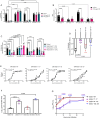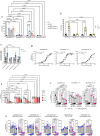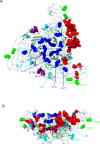Three positively charged binding sites on the eastern equine encephalitis virus E2 glycoprotein coordinate heparan sulfate- and protein receptor-dependent infection
- PMID: 40764487
- PMCID: PMC12325700
- DOI: 10.1038/s41467-025-62513-3
Three positively charged binding sites on the eastern equine encephalitis virus E2 glycoprotein coordinate heparan sulfate- and protein receptor-dependent infection
Abstract
Naturally circulating strains of eastern equine encephalitis virus (EEEV) bind heparan sulfate (HS) receptors and this interaction has been linked to neurovirulence. Previous studies associated EEEV-HS interactions with three positively charged amino acid clusters on the E2 glycoprotein. One of these sites has recently been reported to be critical for binding EEEV to the very-low-density lipoprotein receptor (VLDLR), an EEEV receptor protein. The proteins apolipoprotein E receptor 2 (ApoER2) isoforms 1 and 2, and LDLR have also been shown to function as EEEV receptors. Herein, we investigate the individual contribution of each HS interaction site to EEEV HS- and protein receptor-dependent infection in vitro and EEEV replication in animals. We show that each site contributes to both EEEV-HS and EEEV-protein receptor interactions, providing evidence that altering these interactions can affect disease in mice and eliminate mosquito infectivity. Thus, multiple HS-binding sites exist in EEEV E2, and these sites overlap functionally with protein receptor interaction sites, with each type of interaction contributing to tissue infectivity and disease phenotypes.
© 2025. The Author(s).
Conflict of interest statement
Competing interests: W.B.K. is a co-founder of Advanced Virology. M.S.D. is a consultant or advisor for Inbios, Vir Biotechnology, IntegerBio, Moderna, Merck Sharp & Dohme Corporation, and GlaxoSmithKline. The Diamond laboratory has received additional unrelated funding support in sponsored research agreements from Vir Biotechnology, Emergent BioSolutions, and IntegerBio. S.C.W. is a consultant for Valneva. The remaining authors declare no competing interests.
Figures






Update of
-
Three positively charged binding sites on the eastern equine encephalitis virus E2 glycoprotein coordinate heparan sulfate- and protein receptor-dependent infection.bioRxiv [Preprint]. 2024 Nov 4:2024.11.04.621500. doi: 10.1101/2024.11.04.621500. bioRxiv. 2024. Update in: Nat Commun. 2025 Aug 5;16(1):7227. doi: 10.1038/s41467-025-62513-3. PMID: 39574633 Free PMC article. Updated. Preprint.
Similar articles
-
Three positively charged binding sites on the eastern equine encephalitis virus E2 glycoprotein coordinate heparan sulfate- and protein receptor-dependent infection.bioRxiv [Preprint]. 2024 Nov 4:2024.11.04.621500. doi: 10.1101/2024.11.04.621500. bioRxiv. 2024. Update in: Nat Commun. 2025 Aug 5;16(1):7227. doi: 10.1038/s41467-025-62513-3. PMID: 39574633 Free PMC article. Updated. Preprint.
-
Basic patches on the E2 glycoprotein of eastern equine encephalitis virus influence viral vascular clearance and dissemination in mice.J Virol. 2025 Jun 17;99(6):e0060225. doi: 10.1128/jvi.00602-25. Epub 2025 May 19. J Virol. 2025. PMID: 40387358 Free PMC article.
-
Natural variation in the heparan sulfate binding domain of the eastern equine encephalitis virus E2 glycoprotein alters interactions with cell surfaces and virulence in mice.J Virol. 2013 Aug;87(15):8582-90. doi: 10.1128/JVI.00937-13. Epub 2013 May 29. J Virol. 2013. PMID: 23720725 Free PMC article.
-
Glycosaminoglycan binding by arboviruses: a cautionary tale.J Gen Virol. 2022 Feb;103(2):001726. doi: 10.1099/jgv.0.001726. J Gen Virol. 2022. PMID: 35191823 Free PMC article. Review.
-
The Black Book of Psychotropic Dosing and Monitoring.Psychopharmacol Bull. 2024 Jul 8;54(3):8-59. Psychopharmacol Bull. 2024. PMID: 38993656 Free PMC article. Review.
References
-
- Griffin, D. E. & Weaver, S. C. Alphaviruses in Fields Virology Volume 1 Emerging Viruses Vol. 1 (eds. Howley, P. M. and Knipe, D. M.) 194–244 (Philadelphia, PA Lippincott Williams & Wilkins, 2021).
MeSH terms
Substances
Grants and funding
- R01 AI164653/AI/NIAID NIH HHS/United States
- R01 AI095436/AI/NIAID NIH HHS/United States
- UC7AI180311/Division of Intramural Research, National Institute of Allergy and Infectious Diseases (Division of Intramural Research of the NIAID)
- MCDC 2103-011/United States Department of Defense | Defense Threat Reduction Agency (DTRA)
- T32 AI049820/AI/NIAID NIH HHS/United States
LinkOut - more resources
Full Text Sources

